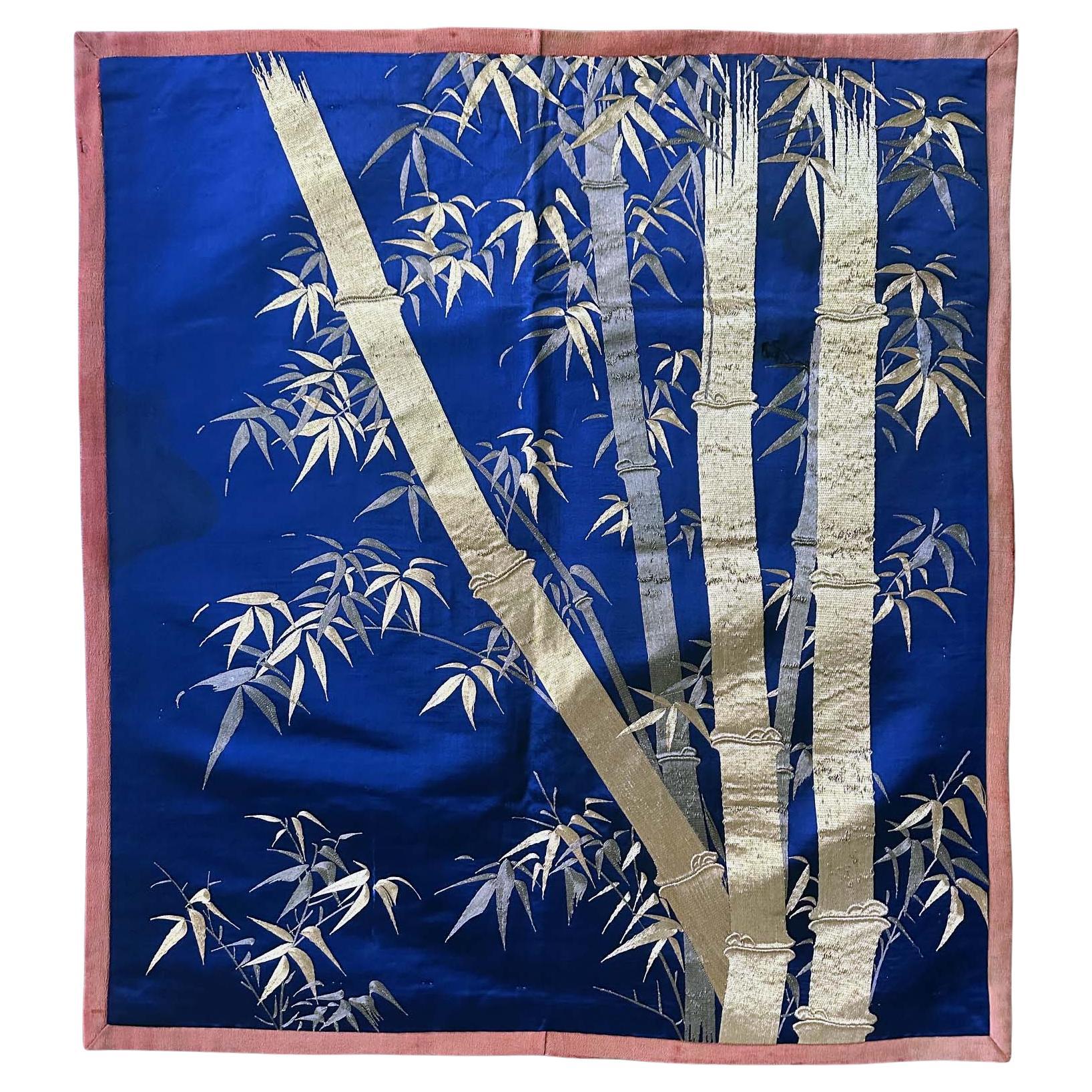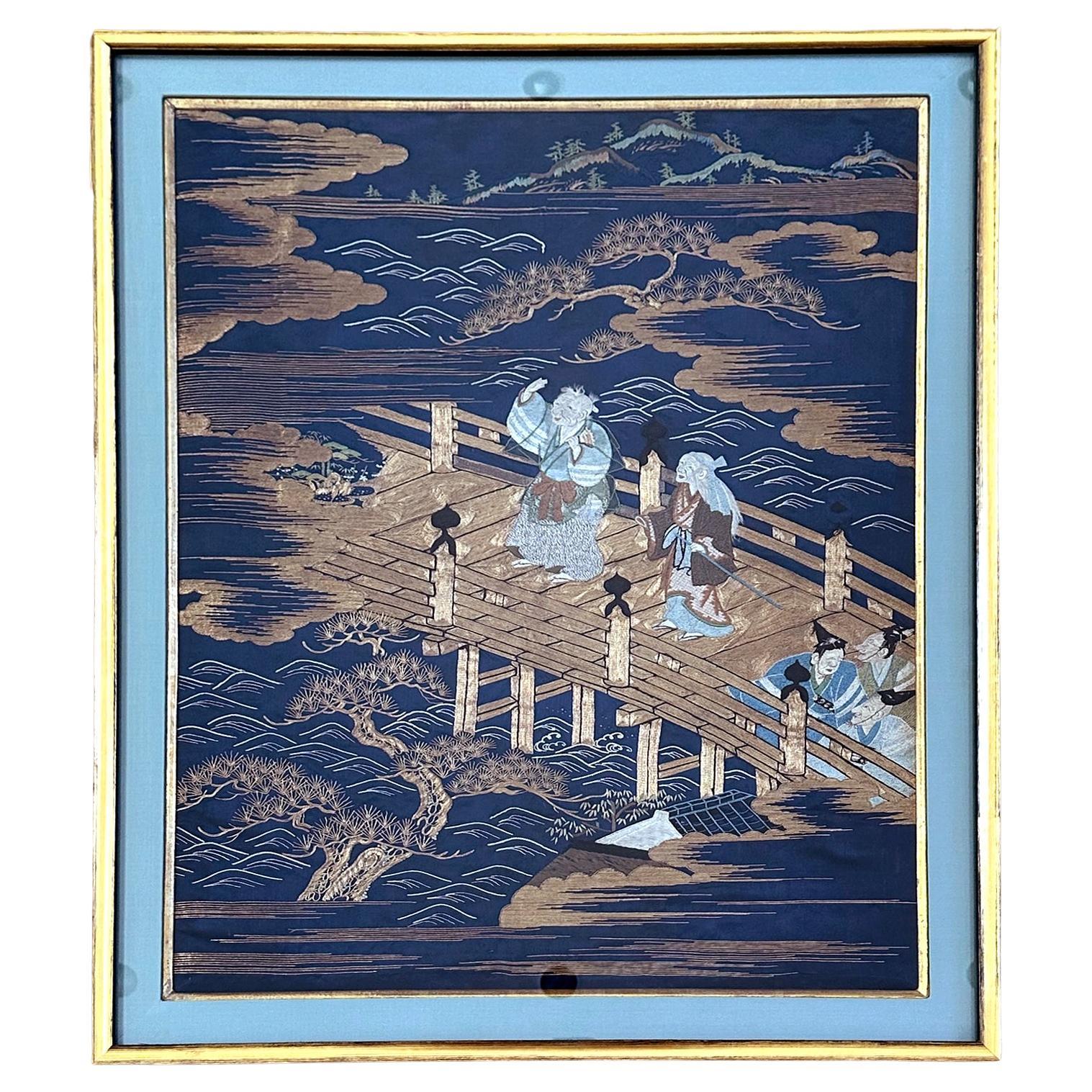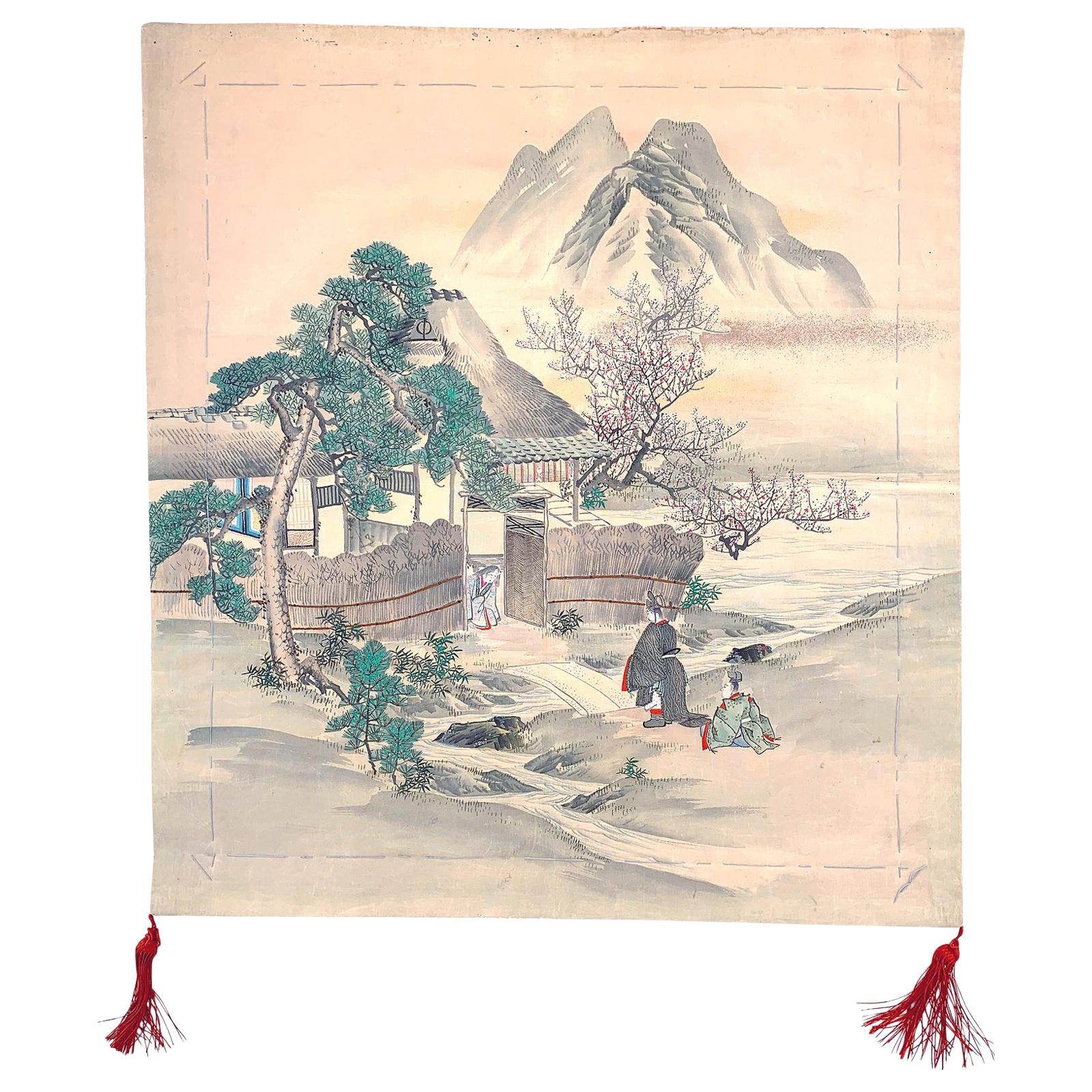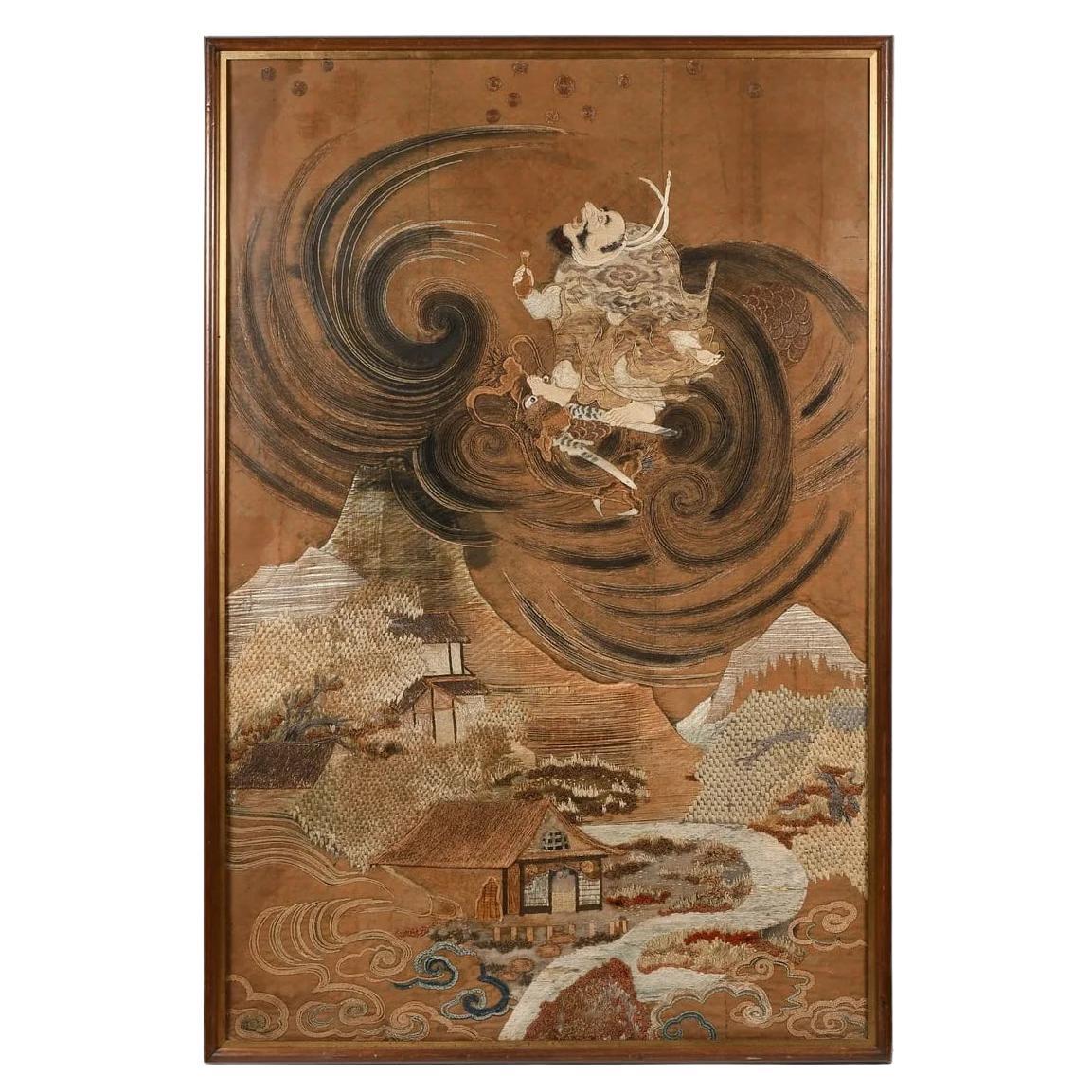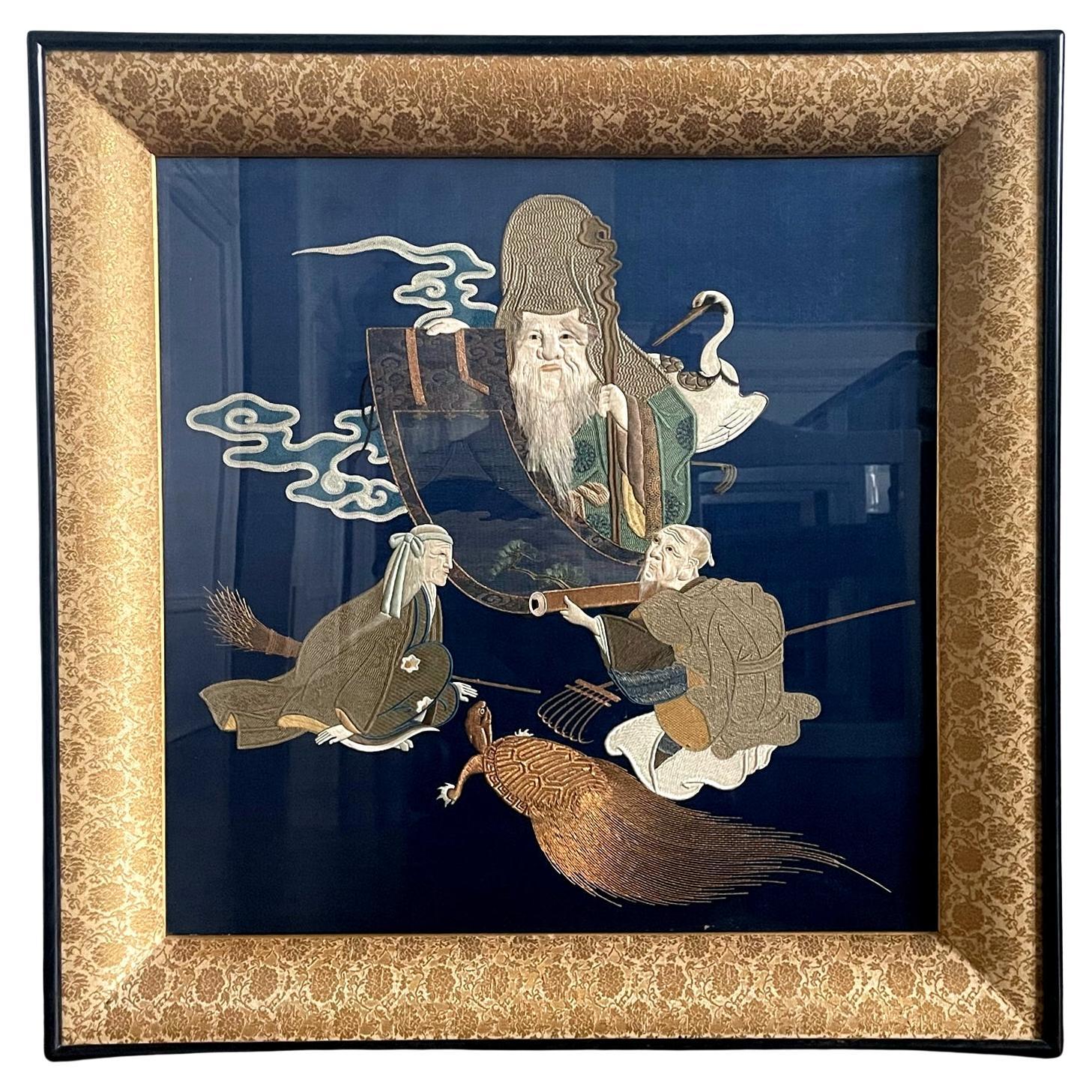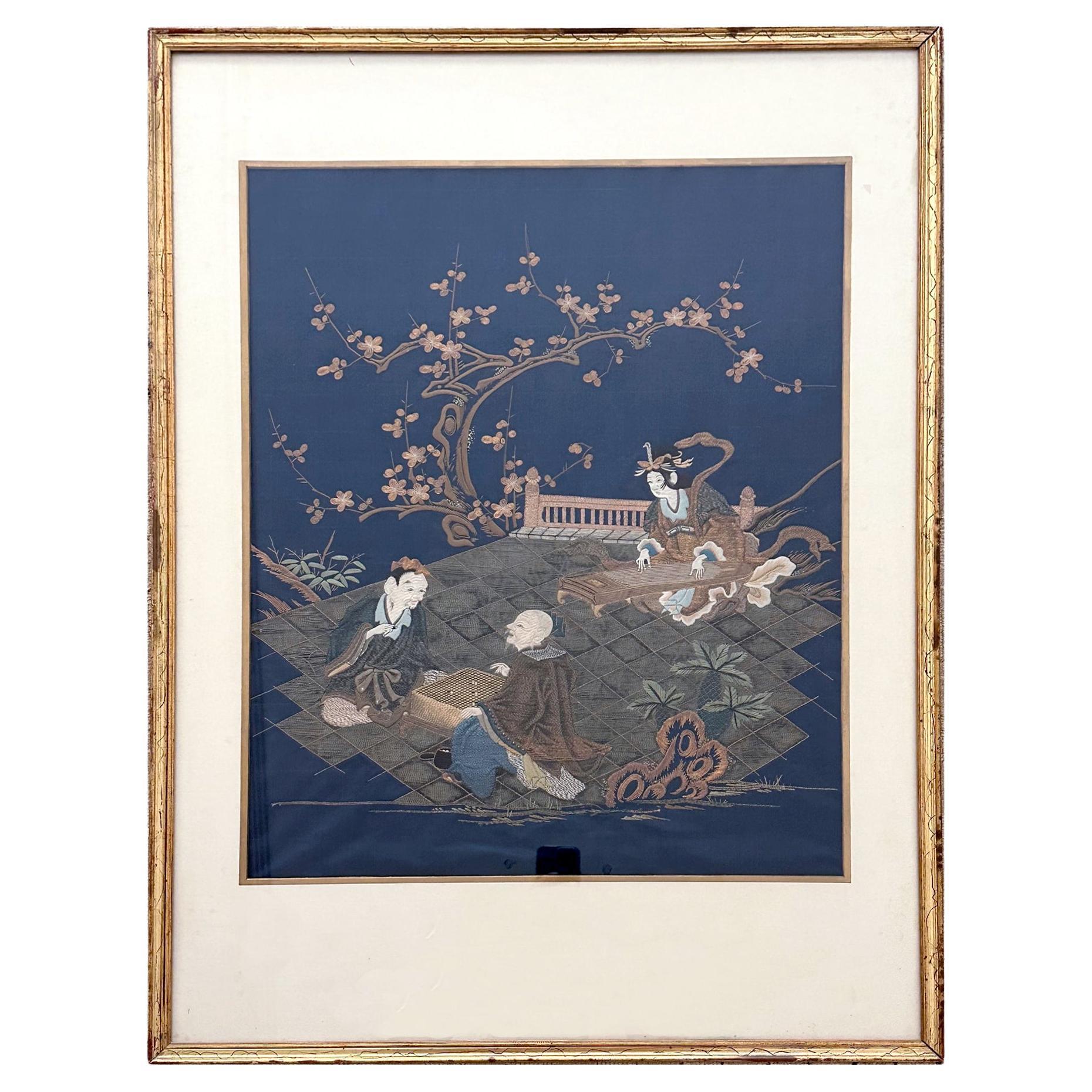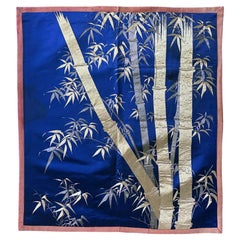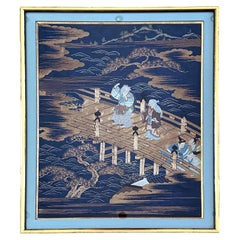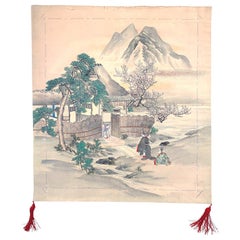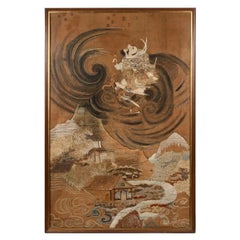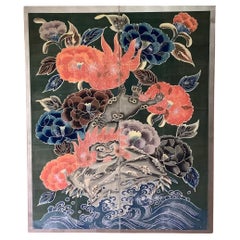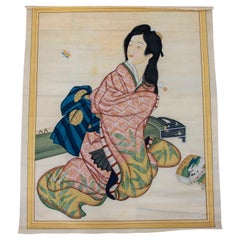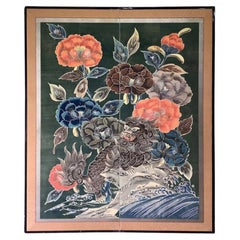Items Similar to Fine Japanese Embroidery Silk Fukusa Kabuki Story Meiji Period
Want more images or videos?
Request additional images or videos from the seller
1 of 18
Fine Japanese Embroidery Silk Fukusa Kabuki Story Meiji Period
$4,000
£3,035.11
€3,470.37
CA$5,586.92
A$6,211.89
CHF 3,243.51
MX$75,613.82
NOK 41,385.72
SEK 38,776.45
DKK 25,900.04
Shipping
Retrieving quote...The 1stDibs Promise:
Authenticity Guarantee,
Money-Back Guarantee,
24-Hour Cancellation
About the Item
A Japanese silk embroidery Fukusa panel circa 1890-1910s toward the end of Meiji Period. The spectacular needlework on this piece is a tour-de-force showcasing a scene from Kabuki theater with the finest techniques and workmanship. On the deep blue satin background, the artist created a complex composition with a fully armored old samurai holding a baby against his chest. A female warrior (known as Onna-Musha in Japanese), also armored, holding a long bow and arrows is at his back. They appear to be traveling through a mountainous landscape with pine groves, dotted with castles and towns (suggested by the white fences and a torii gate).
The Kabuki story of a samurai carrying an infant was about a masterless ronin, an assassin for the shogun, travelled with his infant son to escape his enemies. The story inspired the creation of character Ogami Itto in the 1972 film Lone Wolf and Cub: Sword of Vengeance, which later became a six-part series. A print created by Yoshitaki (1841 - 1899), whose Osaka-school work was known to focus on actors of Kabuki theater, showed a very similar theme (last pic).
The workmanship of this Fukusa is at the finest level. Complex techniques involving variations of couched and chain stitches, padding, satin (long and short) stitches were all employed. The masterly needlework is evident in the even smallest details. The wide range of colored threads, in addition to gold, to create the vivid imagery was also quite astounding. The color remains very bright and vibrant.
The panel was lined with interior hemp support and has a thin red raw silk border all around as well as for the backing. It is unframed.
Fukusa panel was traditionally used as wrapping cloth for the gift presented on the important occasions such as weddings. They tend to be textile art form on their own and often showcase elaborate needlework, Yuzen dye and painting.
- Dimensions:Height: 32.5 in (82.55 cm)Width: 28 in (71.12 cm)Depth: 0.2 in (5.08 mm)
- Style:Meiji (Of the Period)
- Materials and Techniques:Silk,Embroidered
- Place of Origin:
- Period:
- Date of Manufacture:1890-1910s
- Condition:Wear consistent with age and use. Unframed. Fine antique condition, minor discoloration on the backing fabric.
- Seller Location:Atlanta, GA
- Reference Number:1stDibs: LU945043529242
About the Seller
4.9
Platinum Seller
Premium sellers with a 4.7+ rating and 24-hour response times
Established in 2006
1stDibs seller since 2010
564 sales on 1stDibs
Typical response time: <1 hour
- ShippingRetrieving quote...Shipping from: Atlanta, GA
- Return Policy
Authenticity Guarantee
In the unlikely event there’s an issue with an item’s authenticity, contact us within 1 year for a full refund. DetailsMoney-Back Guarantee
If your item is not as described, is damaged in transit, or does not arrive, contact us within 7 days for a full refund. Details24-Hour Cancellation
You have a 24-hour grace period in which to reconsider your purchase, with no questions asked.Vetted Professional Sellers
Our world-class sellers must adhere to strict standards for service and quality, maintaining the integrity of our listings.Price-Match Guarantee
If you find that a seller listed the same item for a lower price elsewhere, we’ll match it.Trusted Global Delivery
Our best-in-class carrier network provides specialized shipping options worldwide, including custom delivery.More From This Seller
View AllJapanese Embroidery Silk Bamboo Fukusa Meiji Period
Located in Atlanta, GA
A Japanese silk embroidery Fukusa panel circa 1890-1910s toward the end of Meiji Period. On the deep blue satin background, the artist showcases a clump of bamboos in a realistic sty...
Category
Early 20th Century Japanese Meiji Textiles
Materials
Silk
Framed Antique Japanese Embroidery Fukusa Panel Takasago Legend
Located in Atlanta, GA
A finely embroidered Japanese silk Fukusa panel presented in a beautiful silk-lined giltwood frame (newly framed and glazed), circa late 19th century of Meiji Period. Fukusa is a traditional Japanese textile art used to wrap and present gifts at important occasions. Depending on the occasion, the panel itself can be a very fine textile art on its own.
On the deep blue background, this elaborate textile art depicts an old couple standing on a bridge with three bystanders, flanked by pine trees with hills afar. The couple is Jotomba (Joo and Uba are their respective names), characters in the Legend of Takasago, one of the oldest Japanese mythologies, who are associated with old pines. The legend goes as: "At Takasago Shrine there is a very old pine tree, the trunk of which is bifurcated; in it dwells the spirit of the Maiden of Takasago who was seen once by the son of Izanagi who fell in love and wedded her. Both lived to a very great age, dying at the same hour on the same day, and since then their spirits abide in the tree, but on moonlight nights they return to human shape to revisit the scene of their earthly felicity and pursue their work of gathering pine needles. His pine tree is called “The Pine of Suminoe” while hers is "Takasago pine".
In Japan, Takasago couple...
Category
Antique Late 19th Century Japanese Meiji Textiles
Materials
Silk, Wood
Japanese Antique Fukusa Textile Art Meiji Period
Located in Atlanta, GA
A Japanese silk Fukusa panel circa late 19th-early 20th century of Meiji Period. The front was beautifully decorated with Yuzen-zome, a labor intensive resist-dye technique invested by an artist monk Miyazaki Yuzensai (1654 -1736) of Edo period. The front cover likely depicts a scene from the Tale of Genji, showing a nobleman and his servant pays a visit to a lady in a fenced thatch-roof house under a high peak. The details of blossom trees and pines, as well as the characters, and scenery with a gradual color are astounding. It is telling that the Yuzen dying was used such an mastery.
The piece has a red silk backing and still retains two red tassels on the lower corners as well as decorative stitches along the edges. There is a patched design on the back likely a Mon symbol (family crest).
Fukusa is a traditional Japanese textile...
Category
Early 20th Century Japanese Japonisme Textiles
Materials
Silk
Framed Japanese Antique Embroidery Sennin Tapestry Meiji Period
Located in Atlanta, GA
A stunning Japanese embroidery tapestry circa 1880s-1900s from late Meiji period, presented with an original wood frame with inner gold trim. The tour-de-force embroidered tapestry s...
Category
Antique 1890s Japanese Meiji Textiles
Materials
Silk, Giltwood
Framed Antique Japanese Embroidery Fukusa Panel
Located in Atlanta, GA
A finely embroidered Japanese silk Fukusa panel presented in a beautiful brocade-wrapped fame. Circa late 19th century of Meiji Period, Fukusa is a traditional Japanese textile...
Category
Antique Late 19th Century Japanese Meiji Textiles
Materials
Silk, Wood
Framed Antique Japanese Embroidery Fukusa Textile Panel
Located in Atlanta, GA
A Japanese silk Fukusa Panel housed in a gilt frame circa late 19th century of Meiji Period. Fukusa is a traditional Japanese textile art used as a wrap for presenting gifts at important occasions. On the deep blue background, the elaborate embroidery work depicts three deities of the Shichifukujin (Seven Gods of Fortune...
Category
Antique Late 19th Century Japanese Meiji Textiles
Materials
Silk, Wood
You May Also Like
Late Edo period Tsutsugaki 筒描 Auspicious Shishi Batik Screen
Located in Fukuoka, JP
Auspicious Shishi Batik Screen
Period: Late Edo
Size: 145x173 cm (57x68 inches)
SKU: PTA62
Step into the mythical world of late Edo Japan with our radiant batik screen depicting the...
Category
Antique 19th Century Japanese Edo Paintings and Screens
Materials
Cotton, Wood
1980s Hand-painted Fabric Traditional Japanese Character
Located in Marbella, ES
1980s Hand-painted Fabric Traditional Japanese Character
Category
Late 20th Century Asian Paintings
Materials
Fabric
Late Edo period Tsutsugaki 筒描 Auspicious Shishi Batik Screen
Located in Fukuoka, JP
Auspicious Shishi Batik Screen
Period: Late Edo
Size: 145x173 cm (57x68 inches)
SKU: PTA62
Step into the mythical world of late Edo Japan with our radiant batik screen depicting the...
Category
Antique 19th Century Japanese Edo Paintings and Screens
Materials
Cotton, Wood
Little Antique Chinese Embroidery
Located in Saint Ouen, FR
Beautiful late 19th century silk embroidery from China with nice design and red field wool foundation.
Category
Antique Late 19th Century Chinese Chinoiserie Textiles
Materials
Wool
$479 Sale Price
20% Off
Rare Spectacular Hand-Embroidered Silk Japanese Kimono
Located in Brea, CA
This highly collectable spectacular rare kimono has detailed hand-embroidery throughout accented . This ceremonial Japanese kimono is hand sewn and hand-quilted throughout.
Category
Early 20th Century Chinese Chinese Export Antiquities
Materials
Silk
Antique Chinese Embroidered Panel
Located in Saint Ouen, FR
Late 19th century Chinese embroidery with silk and metal on silk foundation, entirely hand embroidered, some damages on metal wires.
Category
Antique Late 19th Century Chinese Chinoiserie Textiles
Materials
Metal
More Ways To Browse
Silk On Silk Embroidery
Silk Embroidery Art
Silk Gold Thread
Antique Silk Embroidery
Antique Silk Embroidery Art
Japanese Samurai Art
Japanese Embroidery
Gold Thread Embroidery
Japanese Sword Furniture
Antique Gold Embroidery
Antique Long Bows
Japanese Warrior
Antique Bow And Arrow
Japanese Embroidered
Baby Line
Antique Long Sword
Antique Red Sofa
Silk Gold Thread Embroidery
